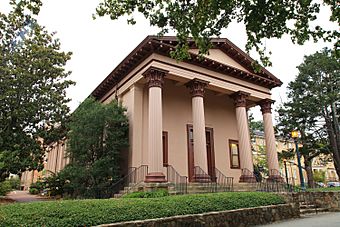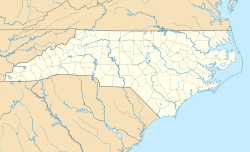Playmakers Theatre facts for kids
|
Historic Playmakers Theatre
|
|
|
U.S. Historic district
Contributing property |
|

Historic Playmakers Theatre, a National Historic Landmark and former home to the Carolina Playmakers theater group
|
|
| Location | Cameron Ave., Chapel Hill, North Carolina |
|---|---|
| Area | less than one acre |
| Built | 1850 |
| Architect | Davis, A.J.; Town & Davis |
| Architectural style | Greek Revival |
| Part of | Chapel Hill Historic District (ID71000604) |
| NRHP reference No. | 71000605 |
Quick facts for kids Significant dates |
|
| Added to NRHP | June 24, 1971 |
| Designated NHL | November 7, 1973 |
| Designated CP | December 16, 1971 |
The Playmakers Theatre, originally called Smith Hall, is a very old and important building. It is located on the campus of the University of North Carolina at Chapel Hill (UNC). This building was finished in 1850.
It is special because of its design, which is called Greek Revival architecture. This style looks like ancient Greek temples. The building was named a National Historic Landmark in 1973. This means it is a place of great historical importance in the United States.
Today, the Playmakers Theatre is a place where plays and performances happen. It is a second stage for the Playmakers Repertory Company. Their main stage is at the Paul Green Theatre.
Contents
What Makes Playmakers Theatre Special?
The Historic Playmakers Theatre building is on the northern side of the UNC campus. It is near the College of Arts and Sciences.
Its Unique Design
The building looks like an ancient Greek temple. It is made of brick, but the outside is covered in stucco. This makes it look like stone.
At one end, there is a special porch called a portico. It has tall, round columns that support a triangular roof section. These columns are unique! They have fancy tops called Corinthian capitals. But instead of just leaves, these tops also show ears of corn and tobacco leaves. These were two very important crops in North Carolina long ago.
The walls of the building also have flat, column-like decorations called pilasters. These pilasters support a simple border around the top of the building.
A Building with Many Lives
Smith Hall was built in 1850. It was part of a big plan to improve the UNC campus. A famous architect named Alexander Jackson Davis helped design it.
When it was first built, it was a place for social events and gatherings. Over the years, it was used for many different things. It was a laboratory, a bath house, and even a law school!
In 1923, the building became a theater. It has been the home of the Carolina Playmakers theater group ever since. Even though the Playmakers Repertory Company now uses the Paul Green Theatre for most of their shows, the Playmakers Theatre is still a very important part of their history and performances.
Images for kids




